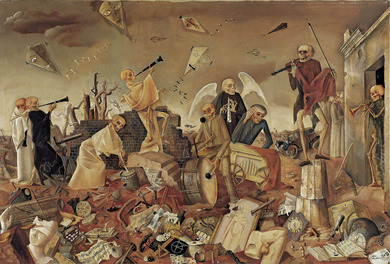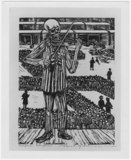Felix Nussbaum: Triumph des Todes (Triumph of Death), painting (1944)
Felix Nussbaum: Triumph des Todes (Triumph of Death), painting (1944)
The painting Triumph of Death, which is reminiscent of a medieval Dance of Death is the last known work by painter Felix Nussbaum. A torn-off calendar page on the right-hand edge of the painting provides information about the date when the painting was completed: 18 April 1944. Only a few weeks later, on 20 June 1944, Nussbaum and his wife, the painter Felka Platek, were arrested by the Wehrmacht following a targeted denunciation. The painter already anticipated while painting that he was doomed. This hopelessness is reflected in the apocalyptic landscape of the late War years presented in Triumph of Death. Instrument-playing skeletons dance around a pile of debris made up of various insignia from the world of art and the sciences. Next to film rolls, musical scores and microscopes, the debris contains objects from Nussbaum’s everyday life like his wife’s tailor’s dummy or his father’s car. Objective testimonials to culture and biographically important objects are thus destroyed equally alongside one another.
The motif of the rotting organ player at the centre of the painting, who bears Nussbaum’s own features, was taken from his 1943 painting Organ Grinder. Various studies for the picture seem to imply that the painter had already been working on the concept for Triumph of Death for some time.




